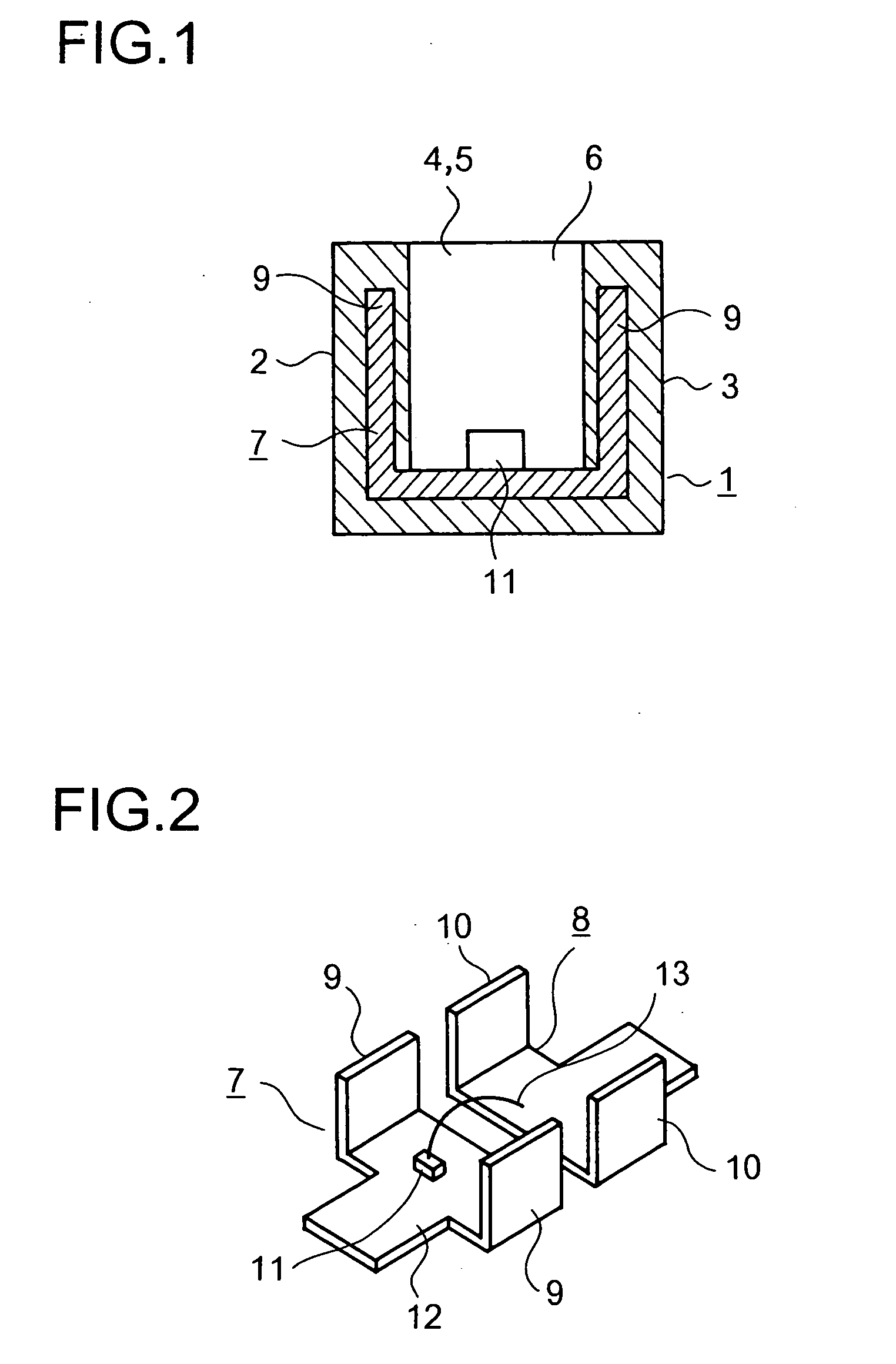Light emitting element
a technology of light-emitting elements and components, which is applied in semiconductor lasers, semiconductor/solid-state device details, lighting and heating apparatus, etc., can solve the problems of increasing the volume of heat generated, increasing the number of processes, and enlarged portions protruding out of the case, so as to achieve less resin leakage and facilitate fabrication.
- Summary
- Abstract
- Description
- Claims
- Application Information
AI Technical Summary
Benefits of technology
Problems solved by technology
Method used
Image
Examples
first embodiment
[0037]FIGS. 1 and 2 show the present invention. FIG. 1 is a cross section of a light emitting element. FIG. 2 is a perspective view of lead frames used in the light emitting element of FIG. 1.
[0038] The light emitting element includes a box-shaped case 1 formed out of an insulating material, such as epoxy resin. The case 1 has a hollow portion 6 formed inside it surrounded by the four side walls 2, 3, 4, and 5 thereof so as to be open at the top. To the case 1 are fixed a first lead frame 7 and a second lead frame 8. The first and second lead frames 7 and 8 are formed out of a conductive material such as copper, iron, or aluminum, and are integrally molded with the case 1.
[0039] As observed in FIG. 2, the first and second lead frames 7 and 8 are mutually symmetrical in shape. Each of the lead frames has two edges bent upward, thereby forming rise portions 9 on the first lead frame 7 and rise portions 10 on the second lead frame 8. When the case 1 is molded, the rise portions 9 and ...
second embodiment
[0045]FIG. 4 shows the present invention. FIG. 4 is a cross section of a light emitting element.
[0046] In the second embodiment, the light emitting element includes a first lead frame 7 and a second lead frame 8 built with the same structure as those shown in FIGS. 2 and 3. The first and second lead frames 7 and 8, however, have rise portions 9 and 10, respectively, which are arranged not inside but along and in close contact with the inner surfaces of the side walls 2 and 3. Thus, the rise portions 9 and 10 directly face a light emitting chip 11, thereby permitting the heat emitted by the light emitting chip 11 to be quickly dissipated.
third embodiment
[0047]FIGS. 5 and 6 show the present invention. FIG. 5 is a cross section of a light emitting element. FIG. 6 is a perspective view of lead frames used in the light emitting element of FIG. 5.
[0048] In the third embodiment, a first lead frame 7 and a second lead frame 8 are mutually symmetrical in shape and structured in the following manner. Specifically, the first lead frame 7 includes: a bottom portion 12; rise portions 9 formed by bending upward the both side edges of the bottom portion 12; a rise portion 20 formed by bending upward an end edge 18 orthogonal to the side edges; and a lead portion 16 protruding from the rise portion 20. The second lead frame 8 includes: a bottom portion 15; rise portions 10 formed by bending upward the both side edges of the bottom portion 15; a rise portion 21 formed by bending upward an end edge 19 orthogonal to the side edges; and a lead portion 17 protruding from the rise portion 21.
[0049] The rise portions 9 and 20 of the first lead frame 7 ...
PUM
 Login to View More
Login to View More Abstract
Description
Claims
Application Information
 Login to View More
Login to View More - R&D
- Intellectual Property
- Life Sciences
- Materials
- Tech Scout
- Unparalleled Data Quality
- Higher Quality Content
- 60% Fewer Hallucinations
Browse by: Latest US Patents, China's latest patents, Technical Efficacy Thesaurus, Application Domain, Technology Topic, Popular Technical Reports.
© 2025 PatSnap. All rights reserved.Legal|Privacy policy|Modern Slavery Act Transparency Statement|Sitemap|About US| Contact US: help@patsnap.com



